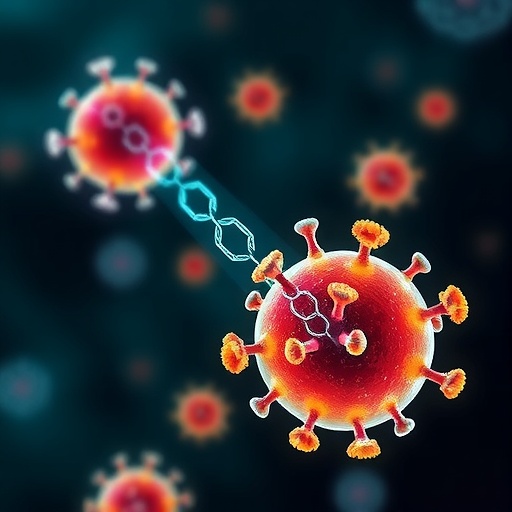In recent years, the field of drug delivery has experienced transformative advancements, particularly with the rise of exosomes as prospective carriers. These biologically derived vesicles have garnered attention for their unique ability to facilitate intercellular communication and transport therapeutic compounds directly to targeted cells. However, challenges persist in harnessing their full potential, especially when it comes to encapsulating larger biomolecules like mRNA and proteins. Traditional methods of loading drugs into exosomes often involve invasive techniques that risk compromising both the therapeutic agents and the integrity of the exosomes themselves, leading to decreased efficacy and increased complexity in processing.
A groundbreaking study led by Dr. Hojun Kim and Dr. Hong Nam Kim from the Korea Institute of Science and Technology (KIST) has introduced an innovative approach that overcomes many of these barriers. By simply mixing cubosomes—lipid-based nanoparticles that replicate cellular membranes—with exosomes, this team has developed a method for efficiently loading large biomolecules into exosomes within just ten minutes. This technique, notable for its simplicity and speed, does not require specialized equipment and eliminates cumbersome purification processes that have previously hindered commercial viability.
Cubosomes serve as a crucial component in this revolutionary technique. With their unique structural characteristics that mimic the natural fusion mechanisms of cell membranes, cubosomes possess an innate ability to integrate with exosomes. When in contact, the cubosomes and exosomes fuse, allowing for the seamless incorporation of therapeutic mRNA. Remarkably, this method demonstrated a remarkable encapsulation efficiency, with more than 98% of the loaded mRNA remaining intact within the exosomes post-processing. Importantly, this advanced method preserves the biological functions of the exosomes, ensuring their efficacy as drug carriers.
Equally significant is the engineered exosomes’ ability to traverse the blood-brain barrier—a daunting challenge in drug delivery. This impermeable barrier complicates efforts to deliver therapeutics to treat neurological conditions, yet the KIST research team discovered that their hybrid exosomes not only crossed this barrier but also exhibited a “homing” effect. This means that these exosomes can return to the original cell type from which they were derived, effectively directing therapeutic agents to diseased tissues and enhancing treatment precision.
The implications of this technology extend far beyond simple drug delivery. By addressing the longstanding hurdles associated with large molecule encapsulation and ensuring the maintained functionality of exosomes, this technique holds promise for therapeutic interventions across various fields, ranging from cancer treatment to therapies for autoimmune diseases and neurological disorders. The adaptability of this method to clinical settings is particularly noteworthy; medical professionals can implement it directly at treatment sites without requiring complex instruments or extensive training.
The research obtained substantial support from KIST’s Major Program, as well as funding under the Individual Basic Research Program and the STEAM Research Program from Korea’s Ministry of Science and ICT. By significantly streamlining the drug delivery process, the study opens new avenues for exosome-based therapies, making them a viable option for precision medicine. The combined expertise of the KIST team positions this technology as a landmark achievement in biomedical research and applications.
Further studies are on the horizon, with plans to evaluate the safety and efficacy of the hybrid exosomes in clinical contexts while establishing a mass production framework for cubosomes. Such advancements could revolutionize how therapeutics are formulated and administered, providing a faster and more efficient pathway to treat a variety of diseases.
Dr. Hojun Kim remarked on the significance of the study, highlighting that this technology empowers clinicians by enabling them to combine exosomes and therapeutic agents with ease, thereby laying crucial groundwork for the realization of personalized medicine. Meanwhile, Dr. Hong Nam Kim expressed optimism regarding the implications for treating complex conditions that necessitate precise drug delivery systems.
This landmark research has been documented in the prestigious journal Nature Communications, further solidifying its contribution to the evolving landscape of drug delivery methodologies. As continuous advancements emerge in the realm of biotechnology, studies like this illuminate the potential of enhancing therapeutic efficacy through innovative engineering and delivery strategies.
The broader scientific and medical communities are now called to explore the implications and applications of this exciting discovery in deeper contexts, analyzing the intersections of nanotechnology, molecular engineering, and drug delivery systems. With each newly unveiled mechanism, researchers edge closer to overcoming the limitations that have long plagued the field, emphasizing the critical role of interdisciplinary collaboration in pushing the boundaries of what is medically achievable.
Promising clinical applications await, and the urgency for drug delivery solutions is more pressing than ever. This research signifies a pivotal moment—one that could radically alter therapeutic pathways by simplifying the loading process, increasing its efficiency, and enhancing the effectiveness of the drugs delivered, thus heralding a new era for cancer therapies and treatments for other challenging medical conditions.
Subject of Research: Drug delivery systems, exosomes, therapeutic cargo loading
Article Title: Fusogenic lipid nanoparticles for rapid delivery of large therapeutic molecules to exosomes
News Publication Date: 23-May-2025
Web References: http://dx.doi.org/10.1038/s41467-025-59489-5
References: Nature Communications, Volume and Issue details as applicable
Image Credits: Korea Institute of Science and Technology (KIST)
Keywords
exosomes, drug delivery, cubosomes, therapeutic mRNA, blood-brain barrier, precision medicine, KIST, drug encapsulation, biomedical research, nanotechnology.




